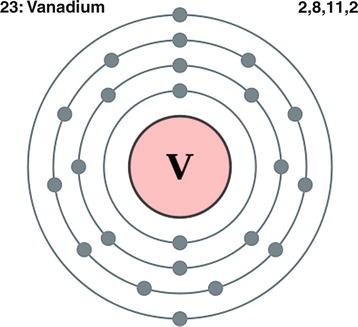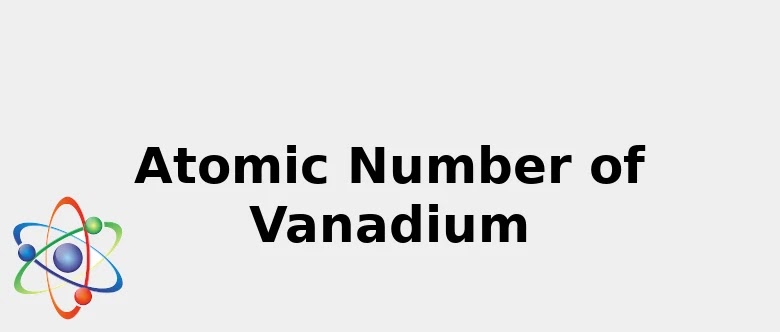Element Vanadium (V), Group 5, Atomic Number 23, d-block, Mass 50.942. Sources, facts, uses, scarcity (SRI), podcasts, alchemical symbols, videos and images. Name: Vanadium Symbol: V Atomic Number: 23 Atomic Mass: 50.9415 amu Melting Point: 1890.0 °C (2163.15 K, 3434.0 °F) Boiling Point: 3380.0 °C (3653.15 K, 6116.0 °F) Number of Protons/Electrons: 23 Number of Neutrons: 28 Classification: Transition Metal Crystal Structure: Cubic Density @ 293 K: 5.8 g/cm 3 Color: Silverish Atomic Structure.
Vanadium: isolation
Isolation: vanadium is available commercially and production of a sample in the laboratory is not normally required. Commercially, routes leading to matallic vanadium as main product are not usually required as enough is produced as byproduct in other processes.
In industry, heating of vanadium ore or residues from other processes with salt, NaCl, or sodium carbonate, Na2CO3, at about 850°C gives sodium vanadate, NaVO3. This is dissolved in water and acidified to give a red solid which in turn is melted to form a crude form of vanadium pentoxide, 'V2O5'. Reduction of vanadium pentoxide with calcium, Ca, gives pure vanadium. An alternative suitable for small scales is the reduction of vanadium pentachloride, VCl5, with hydrogen, H2, or magnesium, Mg. Many other methodsare also in use.
Industrially, most vanadium is used as an additive to improve steels. Rather than proceed via pure vanadium metal it is often sufficient to react the crude of vanadium pentoxide, 'V2O5', with crude iron. This produces ferrovanadium suitable for further work.

Vanadium is a hard metal and was discovered in 1801. It resists corrosion and is widely used to make various alloys.
History and Discovery
Vanadium was discovered by Andres Manuel del Rio in 1801 in Mexico City. He discovered it in a specimen of vanadite. He sent his samples to the Institute den France for inspection and confirmation, but his letter was lost in a shipwreck. Later, Vanadium was rediscovered by Nils Gabriel Sefstrom Swedish chemist who analyzed the samples of iron from a mine in 1830 [1]. Vanadium was isolated by Sir Henry Enfield Roscoe during reaction of vanadium trichloride with hydrogen gas in 1867. Pure vanadium was produced by reducing vanadium pentoxide with calcium in 1927. Vanadium got his named after ‘Vanadis’ who is the Scandinavian Goddess of beauty, as vanadium form various multicolored beautiful compounds.
Vanadium
| Periodic Table Classification | Group 5 Period 4 |
|---|---|
| State at 20C | Solid |
| Color | Blue-silver-grey metal |
| Electron Configuration | [Ar] 3d3 4s2 |
| Electron Number | 23 |
| Proton Number | 23 |
| Electron Shell | 2, 8, 11, 2 |
| Density | 6.11 g.cm-3 at 20°C |
| Atomic number | 23 |
| Atomic Mass | 50.94 g.mol -1 |
| Electronegativity according to Pauling | 1.63 |
Occurrence
Vanadium in native form is rare in nature. It is the 20th most abundant element in the earth crust. It is present in crude oil, coal, oil shale (sedimentary rock) and tar sands deposits. Vanadium is detected spectroscopically in sun light and in the light from other stars. Vanadium in the form of their compounds exit in nature. It is mined mostly in South Africa, North West China and Eastern Russia. Vanadium in the form of vanadyl ion (functional group in which triple bond exit between V4+ and O2-) is present in sea water. Some mineral water also contain vanadium ions in high concentration [2].
Physical Characteristics
Twitwipe.com. Vanadium is silver white, medium hard and ductile metal. It has strong structural strength. Vanadium is resistant to corrosion and is stable in alkalis and acids including, sulfuric acid and hydrochloric acid. It mostly exit in combined form with certain other minerals. The atomic number of vanadium is 23, and atomic mass is 50.914 g/mol. Vanadium melts at 1910oC and boils at 3407oC.
Atomic Radius Of Vanadium
Chemical Characteristics

Vanadium is quite reactive with oxygen, nitrogen and carbon at high temperatures. Vanadium in aqueous solution forms different color complexes like lilac [V(H2O)6]2+, green [V(H2O)6]3+ , blue [VO(H2O)5]2+and yellowVO3–. Vanadium exist in four adjacent oxidation states, +2 to +5. V(II) compounds are strong reducing agent, V(V) are oxidizing agent and V(IV) compounds mostly exist as vanadyl derivatives that contain a VO2+ center. Vanadium pentoxide is used as a catalyst to produce sulfuric acid. Vanadium also form binary halides (VI4, VCL5, VI5) but they are highly unstable. Vanadium also carry out oxidation of organic substances, as oxidation ethanol to form acetaldehyde. Vanadium is miscible in concentrated sulfuric acid, nitric acid, hydrofluoric acid and aqua regia (mixture of concentrated sulfuric and nitric acid) [3].
Significance and Uses
- Vanadium is used to form alloys of steel and iron to impart desirable corrosion resistant characteristics to them.
- In chemical industry, vanadium metal sheets, wires and tubes are widely used.
- Vanadium steel is strong and provides shock resistance.
- Vanadium is extensively used as a catalyst, such as vanadium pentoxide.
- Vanadium pentoxide is also used in ceramics.
- The vanadium redox batteries are used to efficiently store energy.
- It is also used to protect steel against rust and corrosion.
- Vanadium foil is used in cladding of titanium to steel as it has compatibility with both iron and titanium.
- 51V isotopes is used for NMR spectroscopy.
- Vanadium in the form of supplement is used in pharmaceutical applications.
- Vanadium is used as a catalyst in the manufacture process of polyamides, like nylon.
- It is used for the treatment of prediabetes and diabetes.
- Vanadium in used for manufacturing of steel alloys for cutting and grinding purposes.
Health effects
Vanadium act like insulin and functions to increase the effects of insulin. It is used to treat low blood sugar, high cholesterol, heart disease and water retention in the body. Vanadium is non-toxic, but when ingested in large amounts, it increases the risk of kidney damage. Vanadium uptake by humans is mainly through food including, like buckwheat, soya beans, olive oil, apples and eggs. Redmine for mac os. Acute effects of vanadium include irritability of throat, eyes and lungs. Prolonged exposure can cause damage to the nervous system, general weakness and skin rashes.
Isotopes of Vanadium


Vanadium has only one stable isotope, 51V and one radioactive isotope, 50V, that has a half-life of 1.5×1017 years. Twenty-four artificial radioisotopes also have been discovered having atomic mass number ranging from 40 to 65. Most stable in these isotopes is 49V, that has half-life of 330 days.
REFERENCES
[1]. https://education.jlab.org/itselemental/ele023.html

[2]. Rehder, Dieter (2008). Bioinorganic Vanadium Chemistry. Inorganic Chemistry (1st ed.). Hamburg, Germany: John Wiley & Sons, Ltd. pp. 5 & 9–10.
[3]. https://www.britannica.com/science/vanadium
Molybdenum Atomic Number And Mass
Other Periodic Table Elements
- Lanthanum
Lanthanum was discovered in 1838. It is the most reactive member of the lanthanide series…
- Holmium
Holmium was discovered in 1878. It has highest magnetic moment that is why it is… Hs tracker hearthstone.
- Erbium
Erbium was discovered in 1843. Its pink colored Er3+ ions have fluorescent properties useful in…
